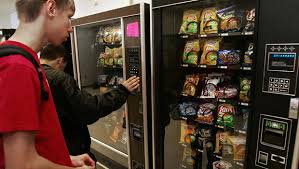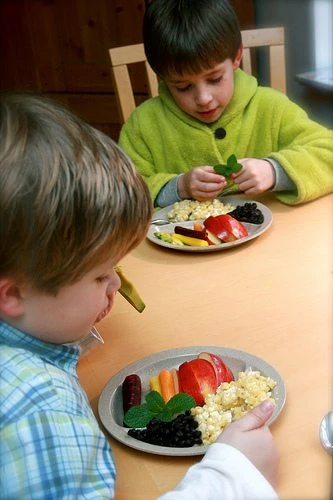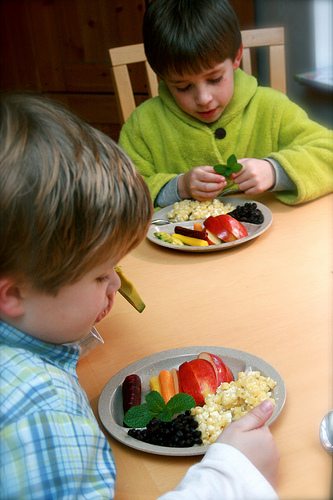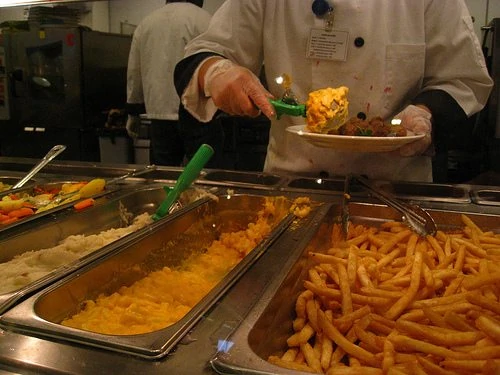cproppe/Flickr
One of the biggest and most persistent obstacles to kids’ making healthy food choices is the heavy marketing of highly processed, usually sugar-laden junk food. It’s not just about outright advertising such as commercials on TV – though there’s plenty to complain about there – but also things like product placements in video games and activity-loaded websites meant to build brand recognition.

Our kids are literally surrounded and bombarded by food marketing on a daily basis. Between this and the easy availability of the junk advertised – along with reduced amounts of recess, PE and other opportunities for physical activity – it’s no wonder that the obesity epidemic shows no sign of let-up.
Fortunately, more parents, educators, health professionals, government officials and others are taking steps to reverse the trends.
For instance, the Nutrition Council of Oregon launched a campaign in 2010 — Marketing Junk Foods to Kids: Oregon’s Parent Awareness Campaign.
The statewide campaign includes ads in 200 TriMet buses, posters and bookmarks in child care and health care facilities, and a Facebook page (www.facebook.com/TooManyAds) with useful links to information on marketing to kids and providing them with healthy food.
The Nutrition Council aims its campaign at parents of young kids. “Children younger than 8 years are cognitively defenseless against advertising,” says Young. “They don’t understand sales techniques and accept claims at face value.”
The Nutrition Council hopes the campaign will raise awareness among Oregon parents about food marketing and provide parents with the information they need to help their kids make good food choices.
“There’s strong evidence that television ads for food and beverages have a direct influence on what children choose to eat,” says Young. “The majority of ads targeting kids are for products high in calories and low in nutrients; foods completely out of balance with healthful diets and contributing to the current obesity epidemic.”
The Nutrition Council of Oregon urges parents to learn all they can about how food marketers target kids, so that they can help their children make good choices about the foods they eat and develop good eating habits that can last a lifetime.
It’s also important for parents – and others who feed children – to learn how to help kids make those good choices. There are a lot of helpful tip sheets out there, but one of the best we’ve seen is the ACE Fitness Matters article “10 Ways to Get Kids to Eat Healthier’. A sample:
1. Model healthy eating. One of the most important actions adults can take to help children eat healthier is to eat healthier themselves. In one study, parental modeling was associated with increased milk, fruit juice and vegetable intake (Young et al., 2004). Another study found that children’s intake of a novel food increased at meals during which they witnessed a teacher enthusiastically eat the food (Hendy and Raudenbush, 2000).
* * *
5. Share the control. Several studies have shown that when a child is allowed to self-regulate food intake, free of any adult pressure or influence, total caloric intake and nutritional value differ only minimally from day to day (discussed in Birch and Dietz, 2008).
On the other hand, encouraging children to eat by focusing on the amount of food left on the plate promotes more food intake and makes children less able to self-regulate caloric intake (Birch et al., 1987). Furthermore, several studies have confirmed that requiring a child to consume a particular food to receive a “reward” such as a dessert, led to increased dislike of the food the child was required to eat and increased liking of the typically unhealthy “reward” food. Higher levels of parental control and pressure to eat are associated with lower fruit and vegetable intake and higher intake of dietary fat (discussed in Birch and Dietz, 2008).
* * *
8. Exploit similarities. Susan Roberts and Melvin Heyman, authors of Feeding Your Child for Lifelong Health (1999), suggest that parents exploit similarities to develop a taste preference for new foods.
Once a food is accepted, find similarly colored or flavored “food bridges” to expand the variety of foods a child will eat. For example, if a child likes pumpkin pie, try mashed sweet potatoes, and then mashed carrots.
Since this article first ran, another study came out that also provides some insight on how we can help kids eat the one thing that most of us need a lot more of anyway: vegetables. How? Give kids veg first:
Children were provided with no carrots or 30 grams (about 1 ounce), 60 grams (about 2 ounces), or 90 grams (about 3 ounces) of carrots as the first course of their lunch.
* * *
The children had 10 minutes to eat the carrots, after which they were served pasta, broccoli, unsweetened applesauce, and low-fat milk. Preschool children who received no first course of carrots, consumed about 23 grams (nearly 1 ounce) of broccoli from the main course.
When the children received 30 grams (about 1 ounce) of carrots at the start of the meal, their broccoli intake rose by nearly 50 percent compared to having no carrots as a first course.
But when the first course was increased to 60 grams (about 2 ounces) of carrots, average broccoli consumption nearly tripled to about 63 grams – or a third of the recommended vegetable intake for preschool children. The extra carrots eaten at the start of lunch did not reduce the amount of broccoli eaten in the main course, but added to the total amount of vegetables consumed.
A journey is not made of one big step but many little steps. Little steps like these can go a long way toward helping kids become more able to make healthy food choices for a lifetime – and perhaps helping ourselves in the process as we take more seriously our role as role models for them.





